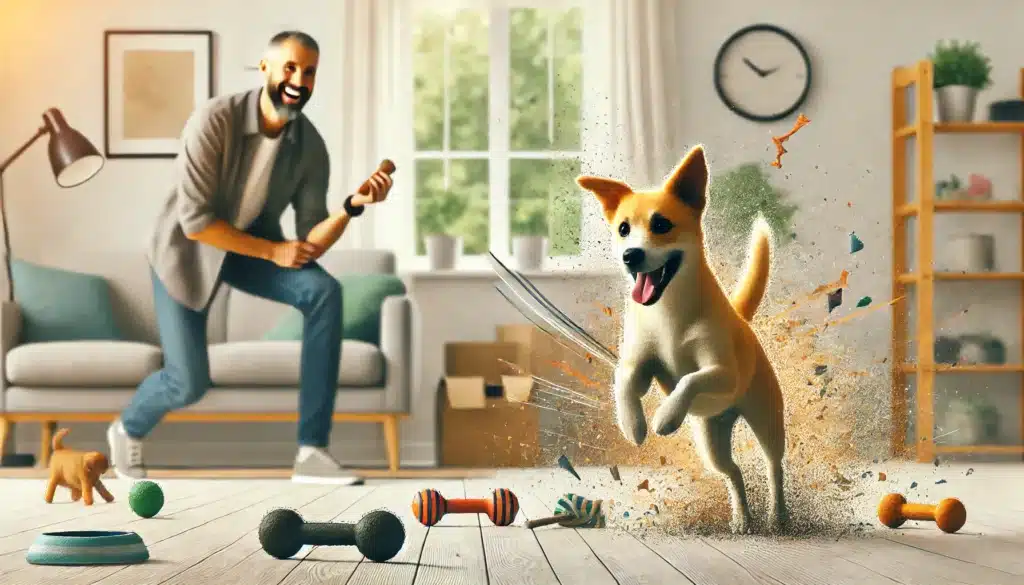If your dog bounces off the walls, doesn’t seem to get tired, or has trouble settling down, you may have what many owners describe as a “hyper” dog. While high energy is normal for many breeds — especially when they’re young — excessive or unmanaged energy can lead to behavior problems, frustration, and even damage around the house.
The good news? With the right approach, hyperactivity can be redirected into healthy, productive behaviors.
In this guide, you’ll learn how to manage your dog’s energy levels, promote calm behavior, and build a routine that works for both of you.
Is My Dog Actually Hyperactive?
True canine hyperactivity (clinical hyperkinesis) is rare and involves a medical or neurological disorder. Most “hyper” dogs are simply under-stimulated or under-exercised — and they’re reacting the only way they know how.
Signs your dog might be over-energized (not truly hyperactive):
- Can’t settle or stay still indoors
- Zooms around the house (also known as “zoomies”)
- Constant barking or demand behavior
- Destructive chewing
- Jumping on people or furniture
- Difficulty focusing during training
- Attention-seeking (pawing, barking, nudging)
If this sounds familiar — don’t worry. Most of this can be improved through routine, exercise, and enrichment.
Step 1: Burn Off That Energy
A tired dog is a calmer dog. But a simple walk around the block may not be enough.
🔁 Combine Physical + Mental Exercise:
- Morning walk: A brisk 30–45-minute walk helps start the day right.
- Fetch or tug-of-war: Great for short, intense bursts of energy.
- Off-leash play (in a secure area): Let them run full-speed safely.
- Dog sports: Agility, scent work, or even swimming for high-drive dogs.
- Flirt pole: A great indoor tool to simulate prey-chase instinct.
Even high-energy breeds can be satisfied with structured and varied activities.
Step 2: Challenge Their Mind
Mental stimulation can tire a dog out faster than physical activity. Try these brain workouts:
- Puzzle toys and slow feeders
- Kong toys stuffed with frozen food
- Hide-and-seek games with treats or toys
- Scent work (find it!) games using nosework cues
- Basic obedience drills in short bursts
Aim for 2–3 short mental games per day — each 5–10 minutes long.
Step 3: Establish a Predictable Routine
Hyper dogs often struggle more in chaotic environments. Create a daily rhythm that includes:
| Time | Activity |
|---|---|
| Morning | Walk + feeding |
| Midday | Chew toy or puzzle |
| Afternoon | Playtime + training |
| Evening | Calm walk + feeding |
| Night | Wind-down and rest |
Routines give structure, reduce anxiety, and build confidence.
Step 4: Use Calm Reinforcement
Reward calmness the same way you’d reward tricks or good behavior.
- When your dog lies down quietly, say “Yes!” and give a treat.
- When they sit instead of jumping, praise immediately.
- If they self-soothe with a toy or bed, quietly drop a treat nearby.
Over time, your dog will learn that calm behavior = reward.
Step 5: Set Clear Boundaries
Don’t unintentionally reinforce hyper behavior. Avoid:
- Giving attention when they jump, bark, or nudge you
- Yelling — it may sound like you’re “joining the excitement”
- Letting them demand play at inappropriate times
Instead, ignore the behavior, wait for calmness, and reward that. Be consistent.
Step 6: Create a Calm Environment
Make it easier for your dog to relax:
- Use a crate or calm zone for naps and wind-down
- Soothing background music (classical, white noise)
- Weighted blankets or calming wraps for anxious energy
- Aromatherapy or calming sprays (vet-approved)
Don’t expect your dog to calm down if the environment is noisy, overstimulating, or chaotic.
Step 7: Teach “Settle” or “Place”
Teach your dog to go to a mat, lie down, and relax on cue:
- Lure your dog onto a mat with a treat.
- When they lie down, say “Settle” or “Place.”
- Reward them for staying on the mat.
- Gradually increase duration and add distractions.
This command is incredibly useful for redirecting energy in public, during mealtimes, or when guests arrive.
Step 8: Watch Their Diet
Some dogs are sensitive to food ingredients that may affect behavior. Consider:
- Switching to a high-quality, balanced diet
- Avoiding excessive sugars, dyes, or fillers
- Reducing high-calorie treats that spike energy levels
Consult your vet if you suspect a food-related sensitivity.
Step 9: Consider Professional Help
If your dog is dangerously out of control or not responding to training:
- Work with a certified professional dog trainer (CPDT-KA)
- Consider a veterinary behaviorist for extreme cases
- Explore calming supplements or medications under veterinary guidance
You don’t have to do it alone — professional support can make a world of difference.
Final Thoughts: High Energy Isn’t a Problem — It’s a Trait
Your dog isn’t “bad” — they’re wired differently. Hyperactivity is often a sign of unmet needs, not disobedience. With structure, patience, and the right outlet, even the most energetic dog can learn to settle, focus, and thrive in your home.
Meet their energy with empathy — and channel it with purpose.







